

I generally liked Westfront 1918 but I have slightly mixed feelings towards it. Especially the combat scenes were incredible (and it's a major part of the movie so it shouldn't be undervalued). Close to the beginning there's a scene with a trench collapsing while there are still soldiers within. This more or less has engraved in my mind. Also generally the approach is really physical. Unlike many other WW I films it renders the battlefield very vast and barren. The climactic long battle which leads directly to the dreadful end at the camp is overall an incredible sequence. Which in my opinion grasps something that other WW I films do not. A lot of it is really connected to the social realism that was so integral to Pabst style. He has a fascinating and compelling take on it as the movie is general, yet not impersonal, apathetic or exploitative. It makes you see a much broader picture than most other war films. The delivery from the battlefield to the camp at the end plays out almost like a metaphor for institutionalized death, like being controlled by a machine. The squeezing of the soldiers under the collapsing trench also connects wonderfully to this imagery, empathizing the desperate position of the soldiers. The spare time spent at home and social establishment seems like an escape from this but it ultimately only draws the soldiers back in.The problem is though that while I greatly admire Pabst sensibilities and unique touches the film feels sort of fragmented and not that dynamic. I really didn't want to see that time spent of the front as I had the feeling I had seen it all before and I knew exactly where it was going and it's not particularly dramatized. It's quite dry in short. I don't really see this as a weakness in general (as keeping it realistic and relatable was essentially the goal of social realism) but it didn't work for me. I thought that the film felt kind of dated in that respect as I would argue that the film was immensely important when it was released but today a lot of the personal context (which people back then brought with them in form of their own experiences) is lost.
... View More"Westfront 1918: Vier von der Infanterie" or "Comrades of 1918" is a German black-and-white sound movie from 1930, so this one was made shortly before the Nazis came into power. The director is Georg Wilhelm Pabst again, one of the most successful filmmakers of his generation. I don't know any of the cast, but writer Ladislaus Cajda, who adapted the novel here for the film, worked with Pabst on several occasions and has his name attached also to a couple big films from that era. "Westfront 1918" runs for slightly under 90 minutes, at least in the version i saw. i see other runtimes here on IMDb and these may either include lost segments or just fewer frames per second.The movie is about a group of German soldiers during the days of World War I. War is depicted here as something gruesome, something that needs to be avoided at all costs because of the pain and casualties it brings. You can imagines that Hitler and his gang did not like this approach at all as they identified with war as something heroic, something inevitable in order to bring Germany to glory. From that perspective, it is certainly an interesting watch, even if Pabst obviously couldn't know yet what would happen in the next 15 years. Being banned by the NSDAP is quality an attribute that makes a film worth seeing, but sadly it is just the approach that is right and interesting. I cannot say I cared for the story here or for any of the characters in particular. Overall, just not a good watch. Thumbs down.
... View MoreThis is a movie that actually doesn't really have a main plot-line in terms of following one main character and have a clear beginning, middle part and end. Just like war there is no logic in it and things just happen within this movie as the movie moves along. It puts you right in the middle of things and shows you the madness of war.It handles all different kinds of aspects from the war. It doesn't only show the situation from the viewpoint of the young soldiers but it also focuses on the family and girls back home. It doesn't do this by featuring it too prominently but picks out an handful of minor characters and just a couple of sequences to get the message across. This works out really well and it doesn't feel melodramatic or anything like that. Modern movies can really learn something from this.But of course foremost the movie gets set in the trenches, somewhere in France. The movie is filled with some WW I battle sequences, which are all surprising good and authentic looking. Guess lots of materials and places from WW I were still around during the production of this movie so they did not have an hard time recreating the look and feeling of the battles fought out in the trenches.It was the first sound movie from Georg Wilhelm Pabst and this shows. Nothing too major, it are just some little things showing you that 'talkies' hadn't been around yet for very long and Georg Wilhelm Pabst wasn't also too experienced with it yet. He pretty much shot this movie in the same way as he would had filmed a silent movie.The movie is of course also original with the fact that it tells the story from the German point of view. While watching this movie you don't actually ever give you the feeling you're watching the movie from the 'evil' and bad point of view. All parties are more or less victims within a war and things are not as black & white as they always seem. Simply a real good and effective WW I production, especially when considering that it got shot way back in 1930.8/10http://bobafett1138.blogspot.com/
... View MoreI found this film utterly gripping. If Wilfred Owen's poems about the first World War could be transferred to film, this would be the result -- dirty, frightening, wholly concerned with the men in the trenches and their loved ones, not the high strategy of war.The crude photography (by later standards), unsophisticated but realistic special effects, the constant barrage of explosions in the soundtrack somehow make this picture of trench warfare more real, as though it were a home movie. But behind the apparent crudity is expert film-making; for example, when the clouds of poison gas blow away only to reveal the advance of unstoppable tanks against a bleak landscape of posts and barbed wire we realize the futility of the entire operation. There is never a distant horizon, just the immediate surroundings or the next line of barbed wire and pickets. Nevertheless, there is little symbolism here, just a close-up picture of how life (and death) in the trenches must really have been.** Possible spoilers follow ** In one of the most compelling scenes, the Student's comrades find his dead body in a mud hole; all they can do for him is throw a few spadefuls of earth on the body. The tight, understated camera-work underlines the restricted world and helplessness of the protagonists. There is a strong emphasis on how the ordinary person is trapped in the process of war. In several scenes an actor apologizes, both in the trenches and when Karl finds his wife in bed with the butcher: each time the subtitle says "It wasn't my fault", but the German is closer to "I couldn't help it". At the end, the mad and dying Karl (Diessl) sums it up: "It's everybody's fault". A French soldier tries to gain comfort from pressing Karl's dead hand; is it hope for rapprochement, or more futility?
... View More